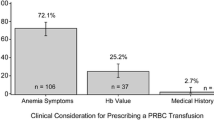Abstract
Goals of work
To outline the use of blood transfusions and erythropoietin-stimulating agents (ESAs) in palliative care in Sweden and to get an idea of whether or not these usually very sick patients benefit from the treatment.
Patients and methods
An internet-based questionnaire was sent out to 24 specialized palliative care units within the Swedish palliative research network. All data were registered by each member directly into a web-based survey generator from which the results were extracted and analyzed.
Main results
Twenty-two units registered 1,046 patients (median age 68 years, 87% had a cancer diagnosis). Among these patients, 900 were enrolled in advanced home care and the others were treated in in-patient units. Erythrocyte transfusions were given to 174 patients (17%) during the month before registration with a mean amount of 2.9 units (range 1–18) given to each patient. Erythrocyte transfusions were given to 18% of the patients with a malignancy and to 11% of the patients with a non-malignant disease. Six patients also received thrombocyte transfusions. One hundred seventeen patients (68%) were judged to benefit from the erythrocyte transfusions. Eighty-two (58%) of the 141 transfused patients enrolled in advanced home care received their transfusions in their homes. ESAs was given to 127 patients (12%).
Conclusions
Transfusions are not uncommon in Swedish palliative care. A majority seemed to benefit from the transfusions. Since they are expensive and time consuming, the effect should, however, be carefully evaluated in every individual in order to avoid ineffective treatment.
Similar content being viewed by others
References
Birgegård G, Aapro MS, Bokemeyer C, Dicato M, Drings P, Hornedo J et al (2005) Cancer-related anemia: pathogenesis, prevalence and treatment. Oncology 68:3–11, doi:10.1159/000083128
Bokemeyer C, Aapro MS, Courdi A et al (2004) EORTC guidelines for use of erythropoietic proteins in anaemic patients with cancer. Eur J Cancer 40:2201–2216, doi:10.1016/j.ejca.2004.07.015
Cella D, Dobrez D, Glaspy J (2003) Control of cancer-related anemia with erythopoietic agents: a review of evidence for improved quality of life and clinical outcomes. Ann Oncol 14:511–519, doi:10.1093/annonc/mdg167
Cella D (1998) Factors influencing quality of life in cancer patients: anemia and fatigue. Semin Oncol 25:43–46
Colton T (1974) Statistics in medicine. Little, Brown and Company, Boston
Davis A, Wang S (1997) Blood transfusions in patients with advanced cancer. J Pain Symptom Manage 13:318
Domen RE, Hoeltge GA (2003) Allergic transfusion reactions—an evaluation of 273 consecutive reactions. Arch Pathol Lab Med 127:316–320
FDA Information for Healthcare Professionals. Erythropoiesis Stimulating Agents (ESA). FDA Alert [11/16/2006, Updated 2/16/2007 and 3/09/2007]
Ganong W (1991) Review of medical physiology, 15th edn. Appleton and Lange, Norwalk, CT
Gleeson C, Spencer D (1995) Blood transfusion and its benefits in palliative care. Palliat Med 9:307–313, doi:10.1177/026921639500900405
Heaton A, Keegan T, Holme S (1989) In vivo regeneration of red cell 2,3-diphosphoglycerate following transfusion of DPG-depleted AS-I, AS-3 and CPDA-1 cells. Br J Haematol 71:131–136, doi:10.1111/j.1365-2141.1989.tb06286.x
Idri S, Catoni MP, Si Ali H, Patte R, Briere J, Baudelot J et al (1996) Transfusion at home? An alternative to the day Hospital. Transfus Clin Biol 3:235–239, doi:10.1016/S1246-7820(96)80002-4
Lindholm E, Daneryd P, Körner U et al (2004) Effects of recombinant erythropietin in palliative treatment of unselected cancer patients. Clin Cancer Res 10:6855–6864, doi:10.1158/1078-0432.CCR-04-0373
Ludwig H, Van Belle S, Barett-Lee P et al (2004) The European Cancer Anaemia Survey (ECAS): a large, multinational, prospective survey defining the prevalence, incidence, and treatment of anaemia in cancer patients. Eur J Cancer 40:2293–2306, doi:10.1016/j.ejca.2004.06.019
Lundström S, Strang P (2004) Establishing and testing a palliative care research network in Sweden. Palliat Med 18:139, doi:10.1191/0269216304pm869xx
Monti M, Castellani L, Berlusconi A, Cunietti E (1996) Use of red blood cell transfusions in terminally ill cancer patients admitted to a palliative care unit. J Pain Symptom Manage 12:18–22, doi:10.1016/0885-3924(96)00044-9
Nowrousian MR (2002) Pathophysiology of cancerrelated anemia. In: Nowrousian MR (ed) Recombinant human erythropoietin in clinical oncology: scientific and clinical aspects of anemia in cancer. Springer Medicine, New York, pp 13–34
Tanneberger S, Melilli G, Strocchi E, Frenquelli C, Pannuti QF (2004) Use of red blood cell transfusions in palliative care services: is it still up to date or is cancer-related anaemia controlled better with erythropoietic agents? Ann Oncol 15:839–844, doi:10.1093/annonc/mdh178
Acknowledgements
The study was supported by a grant from the Swedish Johanniterorden. We thank all participating units in PANIS for their contribution with patient data.
Author information
Authors and Affiliations
Corresponding author
Rights and permissions
About this article
Cite this article
Martinsson, U., Lundström, S. The use of blood transfusions and erythropoietin-stimulating agents in Swedish palliative care. Support Care Cancer 17, 199–203 (2009). https://doi.org/10.1007/s00520-008-0499-9
Received:
Accepted:
Published:
Issue Date:
DOI: https://doi.org/10.1007/s00520-008-0499-9



